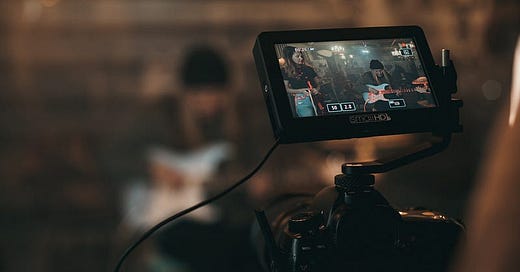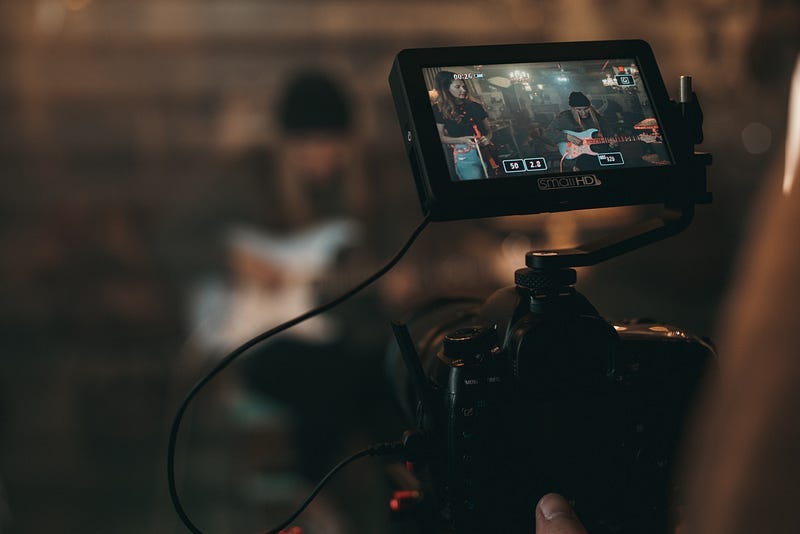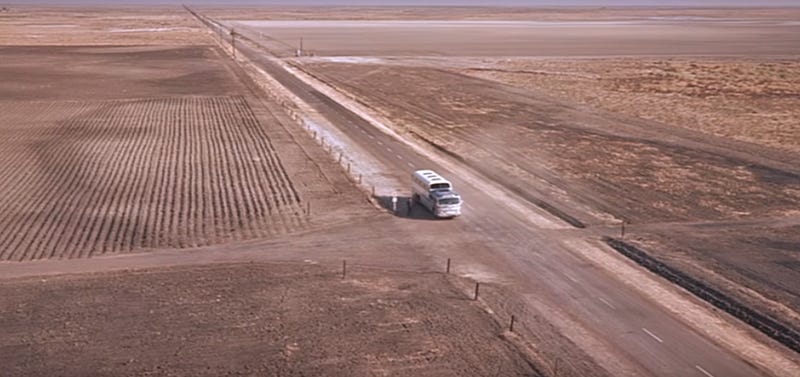Cinematography Explored: Some Of The Greatest Hollywood Cinematic Takes — Part I
Cinematography 101
Cinematography 101
The art of cinematography is a delicate yet resounding art form when it comes to film. The ability to take unique shots that exemplify scenes or make them more compelling for audiences to watch, is a skill that separates the great films from the average ones.
In David Mamet’s book ‘On Directing Film’, which is an intriguing book for aspiring filmmakers, the first question he poses is, “Where to put the camera?”
The art of using the camera in innovative ways, is perhaps my favourite aspect of a great shot.
As a film buff who loves, of course, the score, by & large being a composer & musician myself, I’m also very attracted to great cinematography, & great screenwriting.
Cinematography is a way of storytelling in cinema in its own interesting & expressive way. Shots that are aesthetically pleasing & unique go a long way in making a film a great watch.
In this list, I go through a number of interesting shots from some of the greatest directors, past, present & future.
Alfred Hitchcock — North By Northwest (1959)
It’s imperative to start this list with Alfred Hitchcock, who is going to feature significantly as I go through this list. As a child, I was rather surprisingly drawn to Hitchcock movies, which were aired on the channel AXN in India. But nostalgia aside, I wanted to start with ‘North By Northwest’.
In this scene, Hitchcock’s camera is positioned 200 feet in the air, giving a microscopic view of the protagonist & the bus, and a stunning visual shot of the entire highway and landscape around it.
As the scene cuts into the next, we see the protagonist standing on the sidewalk of the highway as Hitchcock delivers multiple classic shots of vehicles passing, cutting to shots of the landscape and cutting back to the protagonist standing bemused on the side of the highway & then cutting to both characters. It’s a rather remarkable scene & might I add the use of silence as the shots come on screen is also brilliant.
Mikhail Kalatozov - Soy Cuba (1964)
This shot is rather interesting because I’m not sure how they managed it back in the ’60s. It starts from ground level of the funeral procession, focused around a woman, and then zooms out into the heights of the surrounding buildings, which then moves sideways into a Cuban cigar-filling workshop as they then reveal the Cuban flag. But what follows is the camera following the funeral procession at terrace height between the buildings.
This kind of a one-shot take is rather intriguing and with today’s drone technology it’s easier to accomplish. But for the ’60s it surely must’ve been done using moving ladders or a crane. The whole shot of the scene in its entirety is rather impressive.
Danny Boyle, Brian Tufano — Trainspotting (1996)
Coming to the ’90s in a smooth transition, this opening scene to the film ‘Trainspotting’ is perhaps one of the best opening scenes in cinema history.
It begins with a street foot chase with The Stooges/Iggy Pop‘s song— Lust For Life kicking in with the trademark drums and Iggy’s vocals, as the characters are introduced as it cuts to a 5 v 5 football match & then to Ewan McGregor smoking a cigarette and drugged up on a fix of heroin.
McGregor’s entire monologue about choosing life & choosing heroin is brilliantly written and accompanies the shots to fit perfectly as they cut into each other with him passing out on the floor of his apartment.
Alfred Hitchcock — Rebecca (1940)
Hitchcock’s earlier work is the masterpiece Rebecca which has been remade a couple of times. This was Hitchcock freshly brought over from the UK by Selznick & was some of his earliest work in Hollywood.
There are several shots in the film that unravel from one scene to the next. It’s got a number of spectacular shots. But my favourite is perhaps the cliff side scenes. Here’s a rundown of all the exquisite shots from the original Hitchcock film, to the remakes, side by side
Roger Deakins — 1917 (2020)
The film 1917 is an absolute modern day marvel. The entire film is seemingly shot in a single continuous shot as the camera follows the protagonists through the trenches & fields & all the action that happens in the film.
Deakins won an Oscar for his work on the film. And here he is explaining the shots in this video. It’s a collision of older cinematography techniques and using CGI in the modern era. Here’s Deakins explaining the best shots from the film.
William Coleman · David Franco · Jonathan Freeman · Kramer Morgenthau · Stuart Dryburgh · Eric Moynier — Boardwalk Empire (2010)
I’ve been a huge fan of the cinematography used in Boardwalk Empire, my favourite TV show of all time. All the cinematographers I’ve mentioned above do an absolutely stellar job bringing the TV series to life. There are so many varied kinds of shots such as using darker lighting, to high angle & low angle shots during conversations, the attention to detail & of course, the epic gun battle scenes throughout the series. Here’s a short breakdown of the creative decisions used in Boardwalk Empire & some action scenes from the series.
Dion Beebe, Paul Cameron — Collateral (2004)
This scene from Collateral was one of my favourites back in my younger days, especially because of the Audioslave track ‘Shadow On The Sun’ playing as it’s shot. The cuts of the sky & and a plane in the dark with trees ruffling in the wind & the shots of the city lights & the cab with Tom Cruise & Jamie Foxx, is simply sensational. Here’s that remarkable scene & some other explorations of the cinematography from the movie.
Mr. Sunshine — Korean TV Series (2018)
A TV show with some stellar cinematography is Mr. Sunshine which is a Korean drama TV series. Some of the shots are very compelling & aesthetically very well conceived & executed. It’s not just a few shots but a wide range of them from the series.
Alfred Hitchcock — Strangers On A Train(1951)
Hitchcock’s marvelous opening sequence to ‘Strangers On A Train’ is another masterstroke of his cinematography. It begins with a cab arriving at the station and then all the audience can see are the shoes of the protagonists as they make their way through the station, right up to when they meet on the train. It’s an iconic opening scene and the shot of only the main characters’ feet unravels Hitchcock’s trademark elements of suspense.
Stanley Kubrick
Stanley Kubrick is also another pioneer of cinematography, just like Hitchcock. He has dabbled in several genres of film & has made some iconic films in his time. His shot of zooming in on just text in book or paper is sort of similar to Hitchcock. But anyway, this compilation video, has some of Kubrick’s best cinematography from his films over the years.
Alfred Hitchcock — Notorious(1946)
This opening scene by Hitchcock is a masterful one; again showcasing the talents of the legendary filmmaker. I explored this a few years ago when I watched the film, by taking a video of it for Instagram. Here’s what I wrote then:
“Iconic first scene. Hitchcock opens the movie with a shot of a man holding his camera which is a subtle hint at the value he had for his art. Then diagonally moving upwards along with the crescendo in the music shows the sign of the supreme court. Then after briefly showing a man peering through the main court door and capturing the door open slightly, he films the entire court scene from that camera position, which is Classic Hitchcock. The use of this shot can also be seen in -’Banqos Chair’ and the fact that he films it in such a way that the audience is in the onlookers perspective is simplistic and brilliant. The fact that most directors would film this scene inside the court room with close ups separates the master from his disciples.”
David Fincher, Jeff Cronenweth — Fight Club (1998)
Jeff Cronenweth explains his brilliant work on Fight Club. It’s a cult classic film, and a script that’s so hard to explain. Most of the film is shot at night & there are lot of interesting cinematographic scenes. The film’s cinematographer Cronenweth reflects on using a Prada campaign as inspiration & using the semi-noir takes in the film.
Here’s more of Cronenweth’s cinematography exploring his darker takes.
Ben Affleck, Robert Elswit — The Town (2010)
Affleck is better known for his acting, but his direction is pretty interesting as well. Along with Robert Elswit on cinematography, Affleck captures the essence of Boston’s Irish underworld especially Charlestown in 2010’s ‘The Town’. These scenes of a couple of robberies are really well shot, and they’ve got some delicate instances of car wheels, rear view mirrors, breaking windows, slow motion elements, pausing the score to build tension, and it’s well written script wise and shot astutely as well.
Sidney Lumet
Sidney Lumet is yet another filmmaker with a keen eye for excellent cinematography. Lumet’s work also spans many genres from his beginnings in Old Hollywood & B&W cinema to the diverse range of films he’s worked on through the years. This compilation video, has some stand out shots from Lumet’s films.
Alfred Hitchcock — Topaz (1969)
This is an iconic Hitchcock shot where the female lead gets killed. It starts with a sense of tension as the male & female characters talk to each other & is an emotional part of the scene. Then as she gets shot, Hitchcock zooms out to a high shot, vertically above her as the female lead’s dress unfurls in a neat circle as she dies, almost like the blood running out of her.
Jan de Bont — Die Hard (1988)
It doesn’t get more classic than Die Hard. It’s such an epic film & film series. Dutch cinematographer Jan de Bont makes this film come alive as we trace Bruce Willis kicking some serious a*s. Here’s this YouTuber named Nick’s exploration of some of the cinematography techniques used in the first installment of the classic film. “Yippie-kay-yay-motherfu*cker”
Pablo Larrain, Claire Mathon — Spencer(2021)
The Princess Diana biopic was an exquisitely shot film. Kristen Stewart does an impeccable job in the film, and in general the cinematography is probably the best I’ve seen in a film from 2021. Spencer’s score by Radiohead’s Jonny Greenwood brings to life Stewart’s performance. The entire film is shot specifically from Diana’s perspective. Here is an explanation of the cinematography by director Lorrain & Stewart themselves & a technical exploration of the cinematography of the film by a YouTuber.
David Michod, Adam Arkapaw — Animal Kingdom (2010)
Animal Kingdom is a hard-hitting Neo-noir crime drama that’s a must watch if you haven’t seen it. It’s an Australian film that won many awards back when it released. The cinematography by Arkapaw is stunning & very interesting to watch especially if you’re a film school student studying films.
Eric Gautier — Into The Wild (2007)
‘Into The Wild’ is the quintessential film that explores Christopher McCandless’ life. The underlying philosophy of him being disillusioned by modern society & hitting the road to live in the ‘wild’ is rather relevant in these fast-paced, modern times. The cinematography of the film is staggering, with shots of wide open spaces, animals & nature in almost every frame, as it captures McCandless’ adventures. Eddie Vedder’s score is also beautiful, complementing the visuals from the film.
Christopher Nolan, Hoyte van Hoytema — Interstellar (2014)
When it comes to amalgamating landscape shots with CGI, Nolan’s Interstellar has, by far, the most compelling usage of both elements in the film’s cinematography. Telling a story about space travel & love & family, Interstellar teases between shots of the protagonist’s farm house & the team’s adventure through space; it’s got some unbelievable shots & is a definite candidate for the greatest bit of cinematography in the 21st century.
Alfred Hitchcock — To Catch A Thief (1955)
This brilliant shot of the main male & female leads from ‘To Catch A Thief’ as the fireworks go off as they stand on either side of the window is such aesthetically well designed shot.
Hitchcock further uses the fireworks as a representation for s*x as the male & female characters share an intimate moment in the hotel room.
Quentin Tarantino — All Stolen Shots
Tarantino is notoriously famous for stealing from other movies. His famous quote of not going to ‘film school’ but going to ‘films’ is reflected in the way he’s copied shots from cinema from yesteryear for all his films. There are so many instances and parallels of Tarantino stealing shots for his films. This is a short rundown of some of Tarantino’s iconic films along with the films he’s copied the shots from.
Guy Ritchie — Various Cuts
Another great director in his genre is UK director Guy Ritchie. He’s got some unique skills and famously well taken shots to complement well written screenplays. You can always tell it’s a Guy Ritchie movie by just watching a bit of it. His movies with close ups of objects, & iconic fight scenes using slow-motion, and in general, the twists & turns as the film progress are a hallmark of his films. This short video explores some of his stellar shots from his movies.
That’s the end of part I of this series.
In the coming parts I’ll cover other great cinematographic work of other prominent directors like Kurosawa, Scorsese, and more.
I hope you found this post valuable.
If you liked this post, you can buy me a coffee by clicking the link below.







